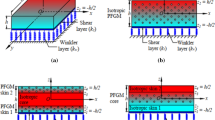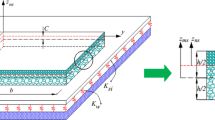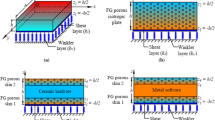An analytical formulation based on a quasi-3D shear deformation theory is proposed to examine the bending response of functionally porous/perfect plates supported on a Kerr/Pasternak/Winkler elastic foundation in hygro-thermo-mechanical conditions. Two kinds of plates, perfect and porous, were studied. For the perfect plates, Mori–Tanaka, LRVE, Voigt, and Reuss models were employed to calculate their mechanical properties changing across the thickness. For the porous plates, different porosity patterns were considered to estimate their mechanical properties. After establishing the governing equations, the Navier solution for simply supported plates was used to calculate their displacements and stresses. The results obtained were compared with data published in the literature, and a good agreement was revealed. Some numerical results were used to investigate the effects of the porosity function, porosity percentage, micromechanical models, and the elastic foundation on the displacements and stresses of a simply supported porous/perfect plate under hygro-thermo-mechanical loadings. The results obtained reveal that these variables have a great influence on the response of the plate in hygro-thermo-mechanical environments.







Similar content being viewed by others
References
S. Dastjerdi and Y. Tadi Beni, “A novel approach for nonlinear bending response of macro and nanoplates with irregular variable thickness under non uniform loading in thermal environment,” Mech. Bas. Des. Struct. Mech., 47, No. 4, 453-478 (2019).
A. Selmi, “Exact solution for nonlinear vibration of clamped-clamped functionally graded buckled beam,” Smart Structures and Systems, 26, No. 3, 361-371 (2020). https://doi.org/10.12989/SSS.2020.26.3.361
A. Garg, M.-O. Belarbi, H. D. Chalak, and A. Chakrabarti, “A review of the analysis of sandwich FGM structures,” Compos. Struct., 258, 113427 (2021). https://doi.org/10.1016/j.compstruct.2020.113427
A. Garg, H. D. Chalak, A. M. Zenkour, M. O. Belarbi, and M. S. A. Houari, “A review of available theories and methodologies for the analysis of nano isotropic, nano functionally graded, and cnt reinforced nanocomposite structures,” Archives of Computational Methods in Eng., 29, 2237-2270(2022). https://doi.org/10.1007/s11831-021-09652-0
A. Garg and H. D. Chalak, “A review on analysis of laminated composite and sandwich structures under hygrothermal conditions,” Thin-Walled Struct., 142, 205-226 (2019). https://doi.org/10.1016/j.tws.2019.05.005.
R. Vaghefi, M. R. Hematiyan, and A. Nayebi, “Three-dimensional thermo-elasto plastic analysis of thick functionally graded plates using the meshless local Petrov–Galerkin method,” Eng. Analysis with Boundary Elements, 71, 34-49 (2016).
J. Guoyong, S. Zhu, S. Shuangxia, Y. Tiangui, and G. Siyang, “Three-dimensional exact solution for the free vibration of arbitrarily thick functionally graded rectangular plates with general boundary conditions,” Compos. Struct, 108, 565-77 (2014)
K. Asemi and M. Shariyat, “Highly accurate nonlinear three-dimensional finite element elasticity approach for biaxial bucking of rectangular anisotropic FGM plates with general orthotropy directions,” Compos. Struct, 106, 235-49 (2013).
H. T. Thai and S. E. Kim, “A simple quasi-3D sinusoidal shear deformation theory for functionally graded plates,” Compos. Struct., 99, 172-180 (2013).
H. Zhang, J. Q. Jiang, and Z. C. Zhang, “Three-dimensional elasticity solutions for bending of generally supported thick functionally graded plates,” Appl. Math. and Mech., 35, 1467-1478 (2014).
M. Jabbari, E. Shahryari, H. Haghighat, and M. R. Eslami, “An analytical solution for steady state three dimensional thermoelasticity of functionally graded circular plates due to axisymmetric loads,” Eur. J. Mech. A/ Solids, 47, 124-142 (2014).
A. F. Radwan, “Quasi-3D integral model for thermomechanical buckling and vibration of FG porous nanoplates embedded in an elastic medium,” Int. J. Mech. Sci., 157-158, 320-335 (2019).
S. A. Al Khateeb and A. M. Zenkour, “A refined four-unknown plate theory for advanced plates resting on elastic foundations in hygrothermal environment,” Compos. Struct., 111, 240-8 (2014).
H. Sung-Cheon, P. Weon-Tae, and J. Woo-Young, “3D graphical dynamic responses of FGM plates on Pasternak elastic foundation based on quasi-3D shear and normal deformation theory,” Composites Part B: Engineering, 95, 324-334 (2016).
F. Ebrahimi, A. Jafari, and M. R. Barati, “Vibration analysis of magneto-electro-elastic heterogeneous porous material plates resting on elastic foundations,” Thin-Walled Struct., 119, 33-46 (2017).
H. Hachemi, A. Kaci, M. S. A. Houari, M. Bourada, A. Tounsi, and S. R. Mahmoud, “A new simple three-unknown shear deformation theory for bending analysis of FG plates resting on elastic foundations,” Steel and Compos. Struct., 25, No. 6, 717-726 (2017).
D. Shahsavari, M. Shahsavari, L. Li, and B. Karami, “A novel quasi-3D hyperbolic theory for free vibration of FG plates with porosities resting on Winkler/Pasternak/Kerr foundation,” Aerospace Sci. and Technol., 72, 134-149 (2018).
S. J. Singh and S. P. Harsha, “Nonlinear dynamic analysis of sandwich S-FGM plate resting on pasternak foundation under thermal environment,” Eur. J. Mech. - A/Solids, 76, 155-179 (2019).
M. G. Shantaram and S. S. Atteshamuddin, “Analysis of functionally graded plates resting on elastic foundation and subjected to nonlinear hygro-thermo-mechanical loading,” JMST Advances, 1, No. 4, 233-248 (2019).
A. Garg, M.-O. Belarbi, H. D. Chalak, and A. M. Zenkour, ”Hygro-thermo-mechanical based bending analysis of symmetric and unsymmetric power-law, exponential and sigmoidal FG sandwich beams,” Mech. Adv. Mater. and Struct. (2021). https://doi.org/10.1080/15376494.2021.1931993
A. Garg, H. D. Chalak, M.-O. Belarbi, A. Chakrabarti, and M. S. A. Houari, “Finite element-based free vibration analysis of power-law, exponential and sigmoidal functionally graded sandwich beams,” J. Inst. Eng. India Ser. C., 102, 1167-1201(2021). https://doi.org/10.1007/s40032-021-00740-5
A. Garg, H. D. Chalak, and A. Chakrabarti, “Bending analysis of functionally graded sandwich plates using HOZT including transverse displacement effects,” Mech. Based Design of Struct. and Machines, 50, No. 10, 3563-3577 (2020). https://doi.org/10.1080/15397734.2020.1814157
A. Garg, H. D. Chalak, and A. Chakrabarti, “Comparative study on the bending of sandwich FGM beams made up of different material variation laws using refined layerwise theory,” Mech. Mater., 151, 103634 (2020). https://doi.org/10.1016/j.mechmat.2020.103634
A. Garg and H. D. Chalak, “Analysis of non-skew and skew laminated composite and sandwich plates under hygro thermomechanical conditions including transverse stress variations,” Journal of Sandwich Struct. & Mater., 23, No. 8, 3471-3494(2021). doi:https://doi.org/10.1177/1099636220932782
P. V. Vinh and L. Q. Huy, “Finite element analysis of functionally graded sandwich plates with porosity via a new hyperbolic shear deformation theory,” Defense Technology, (2021). DOI: https://doi.org/10.1016/j.dt.2021.03.006
P. M. Ramteke, S. K. Panda, and N. Sharma, “Effect of grading pattern and porosity on the eigen characteristics of porous functionally graded structure,” Steel and Compos. Struct., 33, No. 6, 865-875 (2019). DOI: https://doi.org/10.12989/scs.2019.33.6.865
L. Hadji and M. Avcar, “Free Vibration Analysis of FG Porous Sandwich Plates under Various Boundary Conditions,” J. Appl. Comput. Mech, 7, No. 2, 505-519 (2021). https://doi.org/10.22055/jacm.2020.35328.2628
M.-C. Trinh and S.-E. Kim, “A three variable refined shear deformation theory for porous functionally graded doubly curved shell analysis,” Aerospace Sci. and Technol., 94, 105356 (2019). https://doi.org/10.1016/j.ast.2019.105356
B. Srikarun, W. Songsuwan, and N. Wattanasakulpong, “Linear and nonlinear static bending of sandwich beams with functionally graded porous core under different distributed loads,” Compos. Struct., 276, 114538 (2021). https://doi.org/10.1016/j.compstruct.2021.114538
S. R. Mahmoud, E. Ghandourah, A. Algarni, M. Balubaid, A. Tounsi, and F. Bourada, “On thermo‑mechanical bending response of porous functionally graded sandwich plates via a simple integral plate model,” Archives of Civil and Mech. Eng., 22, 186 (2022). https://doi.org/10.1007/s43452-022-00506-5
M. Yaylaci, M. Abnoz, E. U. Yaylaci, H. Ölmez, D. M. Sekban, and A. Birinci, “Evaluation of the contact problem of functionally graded layer resting on rigid foundation pressed via rigid punch by analytical and numerical (FEM and MLP) methods,” Archive of Appl. Mech., 92, 1953-1971 (2022). https://doi.org/10.1007/s00419-022-02159-5
E. Öner, B. Şengül, E. U. Yaylaci, G. Adıyaman, M. Yaylaci, and A. Birinci, “On the plane receding contact between two functionally graded layers using computational, finite element and artificial neural network methods,” J. Appl. Math. and Mech., In Press, (2022). https://doi.org/10.1002/zamm.202100287
M. Yaylaci, E. Adıyaman, E. Öner, and A. Birinci, “Investigation of continuous and discontinuous contact cases in the contact mechanics of graded materials using analytical method and FEM,” Computers and Concrete, 27, No. 3, 199-210 (2021). DOI: http://dx.doi.org/https://doi.org/10.12989/cac.2021.27.3.199
M. Yaylaci, A. Eyüboğlu, G. Adıyaman, E. Uzun Yaylacı, E. Öner, and A. Birinci, “Assessment of different solution methods for receding contact problems in functionally graded layered mediums,” Mech. Mater., 154, 103730 (2021). https://doi.org/10.1016/j.mechmat.2020.103730
M. Yaylaci, M. Yayli, U. E. Yaylacı, H. Ölmez, and A. Birinci, “Analyzing the contact problem of a functionally graded layer resting on an elastic half plane with theory of elasticity, finite element method and multilayer perceptron,” Structural Eng. and Mech., 78, No. 5, 585-597 (2021). DOI: https://doi.org/10.12989/sem.2021.78.5.585
M. Yaylaci, E. Adıyaman, E. Öner, and A. Birinci, “Examination of analytical and finite element solutions regarding contact of a functionally graded layer,” Structural Eng. and Mech.. 76, No. 3, 325-336 (2020). http://dx.doi.org/https://doi.org/10.12989/sem.2020.76.3.325
Y. Jaesang and K. Addis, “Modeling functionally graded materials containing multiple heterogeneities,” Acta Mech, 225, 1931-1943 (2014).
Jr. L. Mishnaevsky, Computational Mesomechanics of Composites, John Wiley & Sons, England (2007).
J. Ju and T. M. Chen, “Micromechanics and effective moduli of elastic composites containing randomly dispersed ellipsoidal inhomogeneities,” Acta Mech., 103, 103-121 (1994).
A. H. Akbarzadeh, A. Abedini, and Z. T. Chen, “Effect of micromechanical models on structural responses of functionally graded plates,” Comp. Struct., 119, 598-609 (2015).
Y. Benveniste, “A new approach to the application of Mori–Tanaka’s theory in composite materials,” Mech. Mat., 6, No. 2, 147-57 (1987). doi:https://doi.org/10.1016/0167-6636(87)90005-6
N. Wattanasakulpong and A. Chaikittiratana, “Flexural vibration of imperfect functionally graded beams on Timoshenko beam theory,” Chebyshev Collocation Method Meccanica, 50, 1331-1342 (2015). https://doi.org/10.1007/s11012-014-0094-8
A. Gupta and M. Talha, “Influence of porosity on the flexural and vibration response of gradient plate using nonpolynomial higher-order shear and normal deformation theory,” Int. J. Mech. Mater. Des., 14, No. 2, 277-296 (2018). https://doi.org/10.1007/s10999-017-9369-2
L. J. Gibson and M. Ashby, “The mechanics of three-dimensional cellular materials,” Proce. R. Soc, London A, Math. Phys. Eng. Sci, 382, No. 1782, 43-59 (1982). https://doi.org/10.1098/rspa.1982.0088
R. Bachir Bouiadjra, A. Mahmoudi, S. Benyoucef, A. Tounsi, and F. Bernard, “Analytical investigation of bending response of FGM plate using a new quasi 3D shear deformation theory: Effect of the micromechanical models,” Struct. Eng. Mech, 66, No. 3, 317-328 (2018). DOI: https://doi.org/10.12989/sem.2018.66.3.317
A. S. Sayyad and Y. M. Ghugal, “Effects of nonlinear hygrothermomechanical loading on bending of FGM rectangular plates resting on two-parameter elastic foundation using four-unknown plate theory,” J. Therm. Stress. 42, No. 2, 213-232 (2019). https://doi.org/10.1080/01495739.2018.1469962
I. M. Mudhaffar, A. Tounsi, A. Chikh, M. A. Al-Osta, M. M. Al-Zahrani, and S. U. Al-Dulaijan, “Hygro-thermo-mechanical bending behavior of advanced functionally graded ceramic metal plate resting on a viscoelastic foundation,” Structures, 33, 2177-2189 (2021). https://doi.org/10.1016/j.istruc.2021.05.090
Author information
Authors and Affiliations
Corresponding author
Rights and permissions
Springer Nature or its licensor (e.g. a society or other partner) holds exclusive rights to this article under a publishing agreement with the author(s) or other rightsholder(s); author self-archiving of the accepted manuscript version of this article is solely governed by the terms of such publishing agreement and applicable law.
About this article
Cite this article
Mekerbi, M., Bachir Bouiadjra, R., Benyoucef, S. et al. Micromechanical Models for Analyzing Bending of Porous/Perfect FG Plates in a Hygro-Thermomechanical Environment by a Quasi-3D Theory. Mech Compos Mater 59, 693–712 (2023). https://doi.org/10.1007/s11029-023-10125-7
Received:
Accepted:
Published:
Issue Date:
DOI: https://doi.org/10.1007/s11029-023-10125-7




